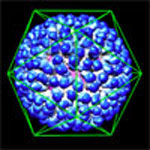Following the pH-dependent Conformational Changes of a Maturing Viral Capsid
summary written by Raven Hanna
The capsid that surrounds viruses is formed from subunit proteins that interact in specific ways to form a tight shell. The processes of coming together and forming interactions are multistep and complex and are fundamental events to acquire viral infectivity. The capsid maturation process of the Nudaurelia capensis omega virus includes pH-dependant conformational changes and auto-proteolysis. Like many human viruses such as HIV and herpes virus, NwV, an insect virus, requires these specific structural changes to become infectious.
A group of scientists led by Prof. Jack Johnson of The Scripps Research Institute performed equilibrium and time-resolved small angle x-ray scattering (SAXS) using SSRL Beam Line 4-2 to investigate the properties of NwV capsid maturation. They found that pH-dependent protonation of some of the residues of the capsid proteins allowed them to pack more closely together causing a size reduction of the entire provirion. This quick conformational change, observed in millisecond to second regime, is followed by the slower process of auto-proteolysis taking place over many hours, resulting in the mature structure. Interestingly, capsids exposed to a lower pH did not require a cleavage step to reach the mature structure.
The authors identified three pH-dependent kinetic stages corresponding to
capsid compression and strengthening. Their study expands understanding of
viral maturation processes. This work was published in the April 7 issue of
Biophysical Journal.
To learn more about this research see the full Scientific Highlight
Matsui, T., Tsuruta, H. & Johnson, J.E. Balanced Electrostatic and Structural Forces Guide the Large Conformational Change Associated with Maturation of T=4 Virus. Biophys. J., 98, 1337-1343 (2010).


